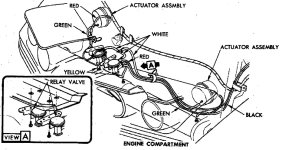Mad4slalom
Well-known user
Hi all, out for a little blast last eve, had lights on 1st position, sidelights on , headlights down . I stopped to top up fuel, by the time I paid and came back to the car, I started up and started to drive out of the forecourt I noticed the headlamps came up unevenly, the wiper door sort of opened and closed and I could hear the astro ventilation flaps in the rear area opening and closing. I then drove off and they settled down and seem normal again now. I know the vacuum tank in the fender is supposed to hold enough vacuum for a couple of operations without motor running , I dont think mine has ever managed that so I think it had lost vacuum while i was refuelling and when I drove off immediately after re starting motor there was insufficient vacuum so the wiper door and lights tried to open as they fail open, by which time the motor had made more vaccum so everything closed again? Is my take on it a possibilty? Maybe a slight leak in head lamp switch ? as normal daytime driving i have no lights or sidelights on so issue of low vacuum doesnt show itself ? Any ideas or suggestions appreciated. TiA 

